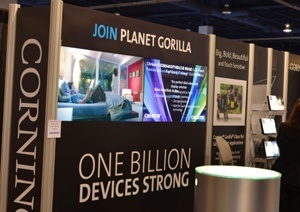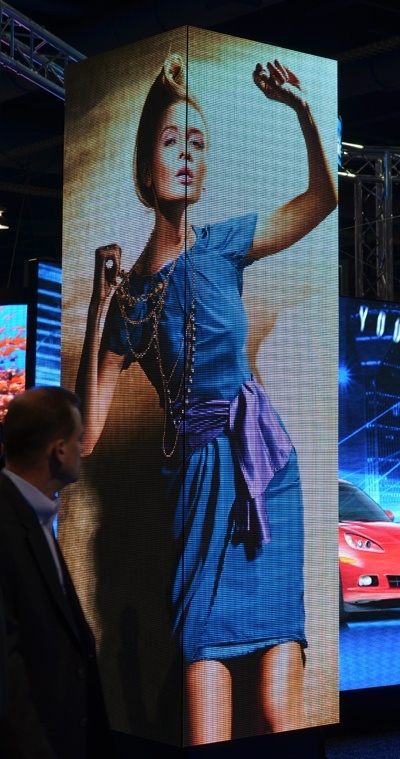
Guest Post: DSE Grows in Size and Energy
March 8, 2013 by guest author, Stephen Randall
This post originally appeared in HDTV Expert
Digital Signage Expo, running from February 26 to 28 this year in Las Vegas, had 22% more exhibitors this year than last, but the growth felt larger than that and the high energy level was palpable. Exhibitors I questioned were pleased with their booth traffic, with some “complaining” of being too busy.
One exhibitor said he didn’t have enough staff to handle the flow. He had six people.
Corning was promoting its Gorilla Glass in large sizes to protect signs located in demanding environments. The displays are Christie 55-inch LCDs with Gorilla Glass directly bonded to the display.
Peter Bocko of Corning Glass was promoting the benefits of Gorilla Glass in large sizes for digital signs. Bocko said that the signage community has the imagination, energy and resources to try new applications and new approaches, while makers of displays for monitors and TVs are too strapped for cash to boldly go where no display has gone before. (Note: I am freely paraphrasing Bocko’s remarks.)
Conventional display people have trouble getting used to the idea that successful digital signage installations are not primarily about the displays. Media creation and delivery, and distribution networks receive more attention. Network software must allow managers to schedule and conveniently reschedule what ads and other media appear on which sign at what time, and must verify that the ads actually appear on the screens they are scheduled to appear on.
Interactive signage, which senses that a person is actually viewing the sign when an ad appears, is already technically well developed, although not yet widely deployed. More advanced versions sense the age and gender of the viewer, opening the possibility of the network operator only getting paid for an exposure when the viewer fits the advertiser’s target demographic. Intel is a major technology developer in this area. There are also digital signs that are interactive in the more conventional sense of touch and gesture interaction.
Still, there is no digital signage without the sign, and the signage divisions of most of the major panel makers had major presences on the show floor. These included Samsung, LG, Sharp, and Panasonic. Significant players who do not make their own panels include NEC, Sony, Viewsonic, DynaScan, Planar, Mitsubishi, BrightSign, StrataCache, 3M, Philips, and Christie. Yes, that Christie. The projection Christie.
Although Christie was not at all bashful about promoting its DLP/LED rear-projection MicroTiles, the bulk of the booth was devoted to flat-panel solutions. Christie is espousing the approach that they are here to serve their customers with whatever technology is most appropriate, and they are stressing a vertical approach that includes sign manufacturing, installation, and network operation, as is appropriate for each customer. Somebody at Christie has been listening to Corning’s Peter Bocko. A 55-inch Christie LCD sign was prominently identified as being protected with directly bonded Gorilla Glass, and Gorilla-ized Christie LCDs were prominently displayed in Corning’s booth.
Nanolumen’s right-angle LED sign (above) was an attention-getter.
Although LCD signs dominated, there was a significant scattering of LED signs on the floor. Nanolumens had a large booth to show off various signs using the company’s flexible LED technology, but the most striking of their signs consisted of two vertical surfaces intersecting at 90 degrees, like the corner of a square post. The images of models wrapping around the corner were strange, and therefore attention-getting.
At Sharp, I spoke with Gary Bailer, the director of product planning and marketing for Pro AV products, which includes both flat-panel signage and projection. He said there is no doubt that larger flat panels are making serious inroads on the projector business in the broad mid-range of image sizes. Inexpensive projectors for elementary education are holding their own, as are powerful projectors for very large images, but the value proposition posed by ever-less-expensive large flat panels is proving impossible for competing projectors to resist.
Panasonic showed an impressive 85-inch plasma touch screen with sophisticated communication capabilities for distance collaboration. A line or signature drawn on the screen tracked the stylus precisely and without lag.
Panasonic’s 85-inch plasma “white” board with sophisticated communications capabilities and SLOT2.0 for convenient embedding of PC functions.
E Ink was energetically promoting passive electrophoretic displays for sunlight-readable, very-low-power signage applications. And the company really was serving coffee to DSE attendees.
Also among the exhibitors showing non-LCD signs was E Ink, with a variety of tiled, very-low-power, monochrome examples. E Ink customer Toppan was presented with a Product of the Year Award from Signage Solutions Magazine for an updated version of its Machikomi (“city communication”) E Ink signs in the Sendai subway system that survived the March 2011 tsunami, and provided one of the few ways that emergency information could be communicated to the population following the disaster.
Several companies were applying 4K panels to the demanding signage environment. LG showed a 4K 84-inch touch sign, which it labeled the world’s first. ViewSonic also showed a 4K 84-inch interactive sign based on AUO, not LG, glass. ViewSonic’s Gene Ornstead said the company is receiving interest from the DoD for interactive mapping apps in command and control centers.
Sharp’s Gen 10 fab, once an albatross around the company’s neck, now gives the company a big advantage in big LCDs for signage and television. This is the 90-inch, and Sharp wasn’t being modest about its size.
Sharp showed the impressive 4K 32-inch with IGZO backplane it has been showing at least since last year’s SID show. Sharp also featured its very large LCD panels — up to 90 inches — engineered into displays for the signage market.
BSI’s 21.5-inch resized and curved LCD. The LCD starts out as a standard panel from LG Display, and is then cut down to a custom size, heated, and curved by Tovis of Incheon, Korea. BSI makes the curved panel into a complete sign.
Resized or bar-type displays – displays that are cut down to a custom size from standard-size panels – were scattered over the show floor, including at the booths of Viewsonic, NEC, and G-Vision, among others.
The most interesting, though, was from Bi-Search International (BSI), which showed a 26-inch LCD that was not only resized to 1366×384 pixels, but was also curved! Lots of interest from beverage companies, said BSI Account Sales Manager Jason Lee. The LCD panel came from LG Display, and was then resized by Tovis (Korea) under the Tannas patent. (Tannas Electronic Displays, which was also exhibiting, distributed a press release announcing that Tannas’s lawyers had filed a new complaint against Luxell Technologies for breach of a previous agreement that had settled a patent infringement suit.)
After resizing the LGD display, Tovis heated the LCD prior to bending it and placing it in its curved bezel, said Tovis’s In Ho Cho. BSI also showed a 47-inch half-cut and curved display with 1920×480 pixels. (Disclosure: Tannas Electronic Displays is one of the author’s clients.)
Finally (at least as far as this column is concerned), transparent displays are very much alive. Planar showed the very intelligently designed refrigerator door it introduced last year, but it is not yet on the market. MRI was promoting its large transparent refrigerator doors with resized displays that fill the entire door, but — unlike last year — did not have a unit on display. Stratacache did have its transparent-display refrigerator door on display. Smaller retail-window and showcase solutions could also be seen over the show floor.
Perhaps most interesting in this segment was a Best Buy kiosk/vending machine for electronic gadgets. The kiosk uses a large, transparent LG panel that showed subjectively good color gamut. Bill Beaton, Senior Director of Product Marketing for ZoomSystems, which manages Best Buy’s 200-kiosk network, said the first of the Kiosks with transparent displays would be deployed in the next couple of months. If the new kiosk shows sufficiently increased sell-through compared to the conventional kiosk it replaces, Beaton is hopeful that more of the transparent-display units will follow.
Although digital signs seem ubiquitous, penetration is still quite low and the current double-digit annual growth can be sustained for years to come. That energy and optimism was reflected in this year’s DSE.








Leave a comment